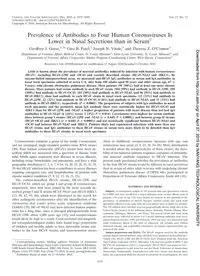
2010 Prevalence of Antibodies to Four Human Coronaviruses Is Lower in Nasal Secretions than in Serum PDF
Preview 2010 Prevalence of Antibodies to Four Human Coronaviruses Is Lower in Nasal Secretions than in Serum
CLINICAL AND VACCINE IMMUNOLOGY, Dec. 2010, p. 1875–1880 Vol. 17, No. 12 1556-6811/10/$12.00 doi:10.1128/CVI.00278-10 Copyright © 2010, American Society for Microbiology. All Rights Reserved. Prevalence of Antibodies to Four Human Coronaviruses Is Lower in Nasal Secretions than in Serum� Geoffrey J. Gorse,1,2* Gira B. Patel,2 Joseph N. Vitale,3 and Theresa Z. O’Connor3 Department of Veterans Affairs Medical Center, St. Louis, Missouri1; Saint Louis University, St. Louis, Missouri2; and Department of Veterans Affairs Cooperative Studies Program Coordinating Center, West Haven, Connecticut3 Received 6 July 2010/Returned for modification 15 August 2010/Accepted 6 October 2010 Little is known about the prevalence of mucosal antibodies induced by infection with human coronaviruses (HCoV), including HCoV-229E and -OC43 and recently described strains (HCoV-NL63 and -HKU1). By enzyme-linked immunosorbent assay, we measured anti-HCoV IgG antibodies in serum and IgA antibodies in nasal wash specimens collected at seven U.S. sites from 105 adults aged 50 years and older (mean age, 67 � 9 years) with chronic obstructive pulmonary disease. Most patients (95 [90%]) had at least one more chronic disease. More patients had serum antibody to each HCoV strain (104 [99%] had antibody to HCoV-229E, 105 [100%] had antibody to HCoV-OC43, 103 [98%] had antibody to HCoV-NL63, and 96 [91%] had antibody to HCoV-HKU1) than had antibody to each HCoV strain in nasal wash specimens (12 [11%] had antibody to HCoV-229E, 22 [22%] had antibody to HCoV-OC43, 8 [8%] had antibody to HCoV-NL63, and 31 [31%] had antibody to HCoV-HKU1), respectively (P < 0.0001). The proportions of subjects with IgA antibodies in nasal wash specimens and the geometric mean IgA antibody titers were statistically higher for HCoV-OC43 and -HKU1 than for HCoV-229E and -NL63. A higher proportion of patients with heart disease than not had IgA antibodies to HCoV-NL63 (6 [16%] versus 2 [3%]; P � 0.014). Correlations were highest for serum antibody titers between group I strains (HCoV-229E and -NL63 [r � 0.443; P < 0.0001]) and between group II strains (HCoV-OC43 and -HKU1 [r � 0.603; P < 0.0001]) and not statistically significant between HCoV-NL63 and -OC43 and between HCoV-NL63 and -HKU1. Patients likely had experienced infections with more than one HCoV strain, and IgG antibodies to these HCoV strains in serum were more likely to be detected than IgA antibodies to these HCoV strains in nasal wash specimens. Coronaviruses comprise a genus of the family Coronaviridae and are enveloped, single-stranded, positive-sense RNA viruses (30). Four human coronavirus (HCoV) strains have been de- scribed, which are associated with a spectrum of disease, from mild, febrile upper respiratory tract illnesses to severe illnesses, including croup, bronchiolitis, and pneumonia, and have a wide geographic distribution (1, 2, 6, 7, 9–14, 16, 20, 25, 26, 31, 32, 35, 39–46). HCoV infection has been a contributor to severe illnesses requiring emergency care and hospitalization of patients with chronic medical conditions (7, 9, 12, 15, 16, 21, 22). The earliest-described HCoV strains, HCoV-229E and HCoV-OC43, which are group I and group II coronaviruses, respectively, have now been joined by the more recently de- scribed group I and II strains HCoV-NL63 and HCoV-HKU1 (13, 30, 42, 45, 46), which were discovered in the search for other pathogenic coronaviruses after the identification of the coronavirus that causes severe acute respiratory syndrome (SARS) (29). HCoV-NL63 may have infected human popula- tions for a long time, since it diverged phylogenetically from HCoV-229E about 1,000 years ago (33), and seroprevalence would likely be high as a result. Cross-sectional and longitudi- nal seroepidemiological studies have found large proportions of children and healthy adults to have detectable serum anti- bodies to the four HCoV strains, and seroconversion occurs often in childhood; seroprevalence increases with age, and reinfections may occur (5, 8, 23, 28, 36–38). More information is needed about the seroprevalence of these viruses, the dura- bility of the humoral immune response, correlates of immunity, and mucosal antibody responses to HCoV infection. The present study questioned whether the prevalence of antibodies to the four HCoV strains would be different in nasal secretions than in serum of older adult veterans with underlying chronic obstructive pulmonary disease (COPD) who participated in Department of Veterans Affairs Cooperative Study 448 (18). MATERIALS AND METHODS Subjects. A convenience sample of 105 patients who met spirometric criteria for COPD and were enrolled in a larger influenza virus vaccine efficacy trial of patients �50 years of age (18) were chosen for analysis in this substudy of the prevalence of antibodies to HCoV, because residual serum and nasal wash specimens collected at the same time for each subject were available for analysis. The 105 subjects were enrolled at seven geographically diverse study sites in the United States, located in the following states: Alabama, Florida, Illinois, Mas- sachusetts, Michigan, Missouri, and Texas. The paired serum and nasal wash specimens were collected at about 3 to 4 weeks following influenza virus vacci- nation between October 1998 and February 1999 and were not associated with acute respiratory illness at the time of collection. All patients gave written informed consent, and responsible committees on human experimentation ap- proved of the study. Antigen preparation and ELISA. The HCoV antigens used for the antibody enzyme-linked immunosorbent assay (ELISA) were produced as described pre- viously (16). HCoV-229E and HCoV-OC43 were obtained from the American Type Culture Collection (ATCC, Manassas, VA) and were grown in MRC-5 and HCT-8 cell monolayers (ATCC), respectively. HCoV-NL63 was grown in LLC- MK2 cell monolayers (a gift from Lia van der Hoek, University of Amsterdam, Amsterdam, Netherlands). Virus-infected cells were frozen and thawed three times, the supernatant fluid was cleared of cell debris by centrifugation, the virus * Corresponding author. Mailing address: Division of Infectious Diseases and Immunology, Saint Louis University School of Medicine, 1100 South Grand Boulevard, DRC-8th Floor, St. Louis, MO 63104. Phone: (314) 977-5500. Fax: (314) 771-3816. E-mail:
